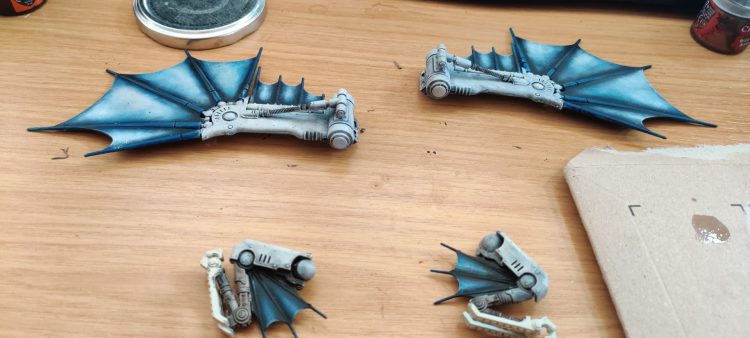In our How to Paint Everything series, we take a look at different armies of the Warhammer universe, examine their history and heraldry, and look at several different methods for painting them. With the release of Engine War, we’re taking a look at the cybernetic warriors of the Adeptus Mechanicus and how to paint them, with several methods and schemes.
Who Are the Adeptus Mechanicus?
The Adeptus Mechanicus have a long history in 40k, having appeared all the way back in Rogue Trader. They then more or less disappeared from the game, with a few scattered markers – a Cult Mechanicus symbol here, a metal Tech-priest Enginseer there – until 7th edition saw them re-released in the slightly weird format of two separate codexes, Skitarii and the Cult Mechanicus. A decision driven more by marketing and what would be manageable to release in the then-weekly White Dwarf (yes, really), but it did the job of getting Ad Mech back into the game. As we approach the end of 8th edition, Engine War has just been released, and the Tech-priests have seen a flurry of model support – the Tech-priest Manipulus, the Skitarii Dunerider and Disintegrator, and then a whole set of new kits released alongside their Psychic Awakening book. It’s a good time to worship the Void Dragon Omnissiah.
In the lore, the Adeptus Mechanicus are an interesting piece of the Imperial puzzle. While the Emperor was fighting the Unification Wars on Terra, the Tech-priests were sitting pretty on Mars, organised as the Mechanicum – an entirely separate empire. After the Emperor’s formation of the Imperium, the Mechanicum agreed to join the Great Crusade, not as a subject but as an ally – the Mechanicum would retain sovereignty over its Forge Worlds, in return for supplying the Imperium’s engines of war. The Emperor was fitted into the Ad Mech’s cosmology as an embodiment of the Omnissiah, and peace and joy reigned.
Well, they reigned for a while, anyway. A faction of the Mechanicum never really took to the alliance with the Imperium, and when the Horus Heresy split the Imperium in half the Mechanicum experienced a similar split. The Fabricator-General Kelbor-Hal, the highest-ranking member of the Mechanicum, was swayed to Horus’ side. His deputy, Fabricator Locum Kane, stayed loyal. Like the other divisions of the Horus Heresy the civil war within the Mechanicum was vicious and brutal, but in the end the loyalists were on the side of history and the traitors were cast out, becoming the Dark Mechanicum while the remaining loyalists formed the Adeptus Mechanicus, a successor state to the original Martian empire.
Post-Heresy, the Mechanicus has continued to operated as the premier technological organisation of the Imperium, its tech-priests hunting down any scraps of knowledge they can find in their endless Quest for Knowledge.. Despite their efforts, however, their knowledge is on a downwards slide – technology from the Great Crusade can no longer be produced, and even the Golden Throne is struggling. Fighting back against this tide are tech-priests like Archmagos Belisarius Cawl, who seek to not only recover what was lost, but once again begin innovating and creating something new, even in the face of the Cult Mechanicus’ own beliefs.
Where to Read More
If you want to read more about the early Mechanicum, before they became the Adeptus Mechanicus, there’s no better place to start than the eponymous Mechanicum which is book 9 in the Horus Heresy series and one of the better-regarded early books. There’s also the short story Cybernetica, in the same time period.
For a more modern take on the Adeptus Mechanicus, set in the Dark Imperium period after the opening of the Great Rift, then Belisarius Cawl: The Great Work is more or less essential reading, with its focus on the key figure in the Adeptus Mechanicus. The Forges of Mars omnibus is a little older, but it’s packed with Adeptus Mechanicus action.
Playing Adeptus Mechanicus
Warhammer 40,000
Adeptus Mechanicus are a really fun faction in 40k, and they just got a new brand new Codex for 9th edition. You can read our review here.
Kill Team
You can read all about the toaster boys in our Kill Team Tactics article here.
Painting Adeptus Mechanicus
Andrew “Pendulin” Haywood’s Method
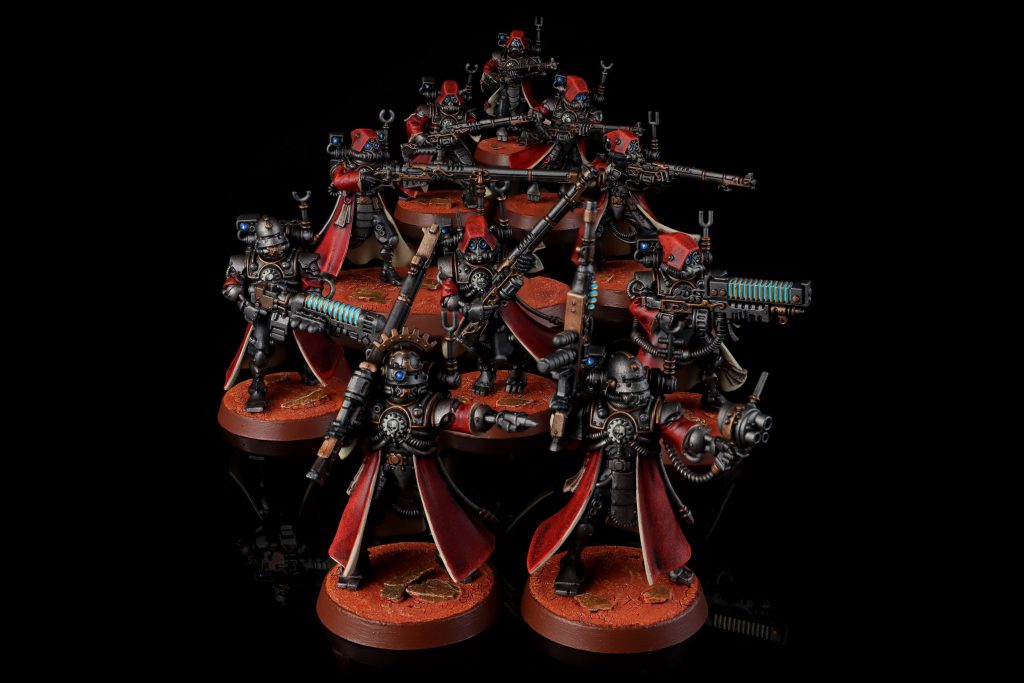
Adeptus Mechanicus is the reason I got into Warhammer. The H.R. Giger-esque fusion of machinery and humanity was exactly what I was looking for, and the model range has only gotten better with their latest model releases. However, those models can be extremely intimidating due to all the wires, antennas, and mechadendrites. But fear not! This is my recipe for great looking Admech, and it’s simple as radioactive pie. This guide isn’t for a specific model, but it instead covers the different steps I follow when painting any generic Admech model.
Step 0: Subassembly
This is the biggest tip I have for anyone working on Admech: subassemble as many components as you feel comfortable doing and paint them independently. Even down to the basic Skitarii, I separately paint the backpack, model, head, and base. For larger models like Kataphrons, Tech-Priests, Cawl, Dragoons, etc. just use your best discretion on where to subassemble.
Step 1: Prime
The easiest option here is with a rattlecan of Citadel Leadbelcher spray paint. While this is extremely easy, there is some risk here. When held at arm’s length, wet Leadbelcher spray looks quite similar to unprimed grey plastic. So you might accidentally miss some areas. If you want to avoid that, or just be extra thorough, you can prime black with an airbrush (Stynylrez Black is my choice), and then airbrush a silverish metallic (Vallejo Metal Color Steel).
Step 2: Cloak
- Base Mephiston Red. On your palette, thin the paint with just a touch of water or flow improver, and then apply multiple thin coats to the exterior of the cloaks and hoods.
- Wash Nuln Oil. Wash all the red bit in Nuln. Don’t skimp, either. Really get that Nuln all up in there.
- Drybrush Mephiston Red. Get a nice scratchy look across the entire cloak, breaking up any pools of Nuln Oil that formed.
- Light drybrush Evil Sunz Scarlet. Go over the whole cloak, but focus on areas that are billowing out, edges, and corners of the cloak. Go a little lighter than your drybrush of Mephiston Red.
- Even lighter drybrush Wild Rider Red. Only hit the edges, corners, and areas that would be getting direct sunlight. Go lighter with this than with Evil Sunz Scarlet.
- Optional: Super light drybrush Fire Dragon Bright. This color will absolutely stand out, so use it extremely sparingly on the very tips of the cloak. I don’t even use it on Skitarii, and instead reserve it for larger cloaks like on Tech-Priest Dominus or Belisarius Cawl himself.
- Cleanup: This many layers of drybrush probably got red paint all over the model. Spend some time cleaning up any areas that you want to remain metalic colored. Don’t worry about areas that will be painted other colors (the inside of the cloak, the black leather pants).
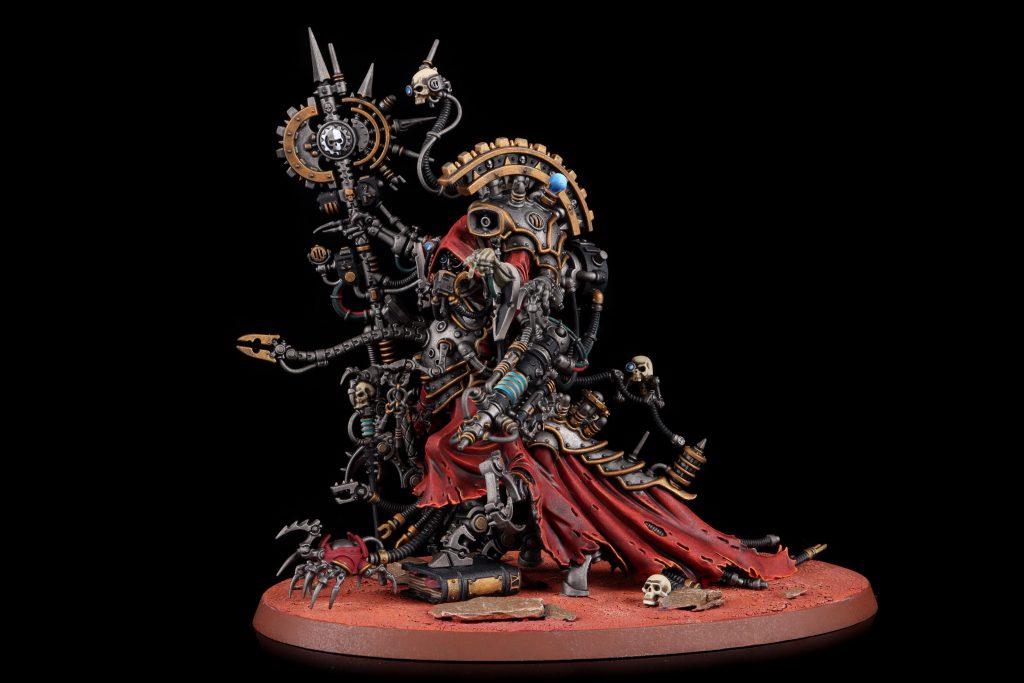
Step 3: Black Areas (pants, cables)
The black parts may look tricky to paint, after all, how are you going to get multiple smooth layers of black paint all over these legs that are wrapped in cloaks at odd angles? But I’ve got a secret that makes it trivially easy.
- Black Templar Contrast paint. Use 1 layer of this on all areas that you want to turn black. Done. If it’s not dark enough for your tastes, wait for it to fully dry then put a second layer of Black Templar on.
- Cleanup. If you accidentally get some Black Templar on areas you want to be colored other than black, clean that up now.
Step 4: Cloak Interior
Paint the interior of the cloak with Ushabti Bone. You’ll want to thin this down and apply multiple thin coats. Also paint the very edges of the cloak with Ushabti, but take extreme care to not accidentally paint over the red cloak, as it’s a pain to correct.
Step 5: Wooden Elements
Some Skitarii weapons have wooden elements in the stock. Cover those spots with a layer of Wyldwood Contrast Paint.
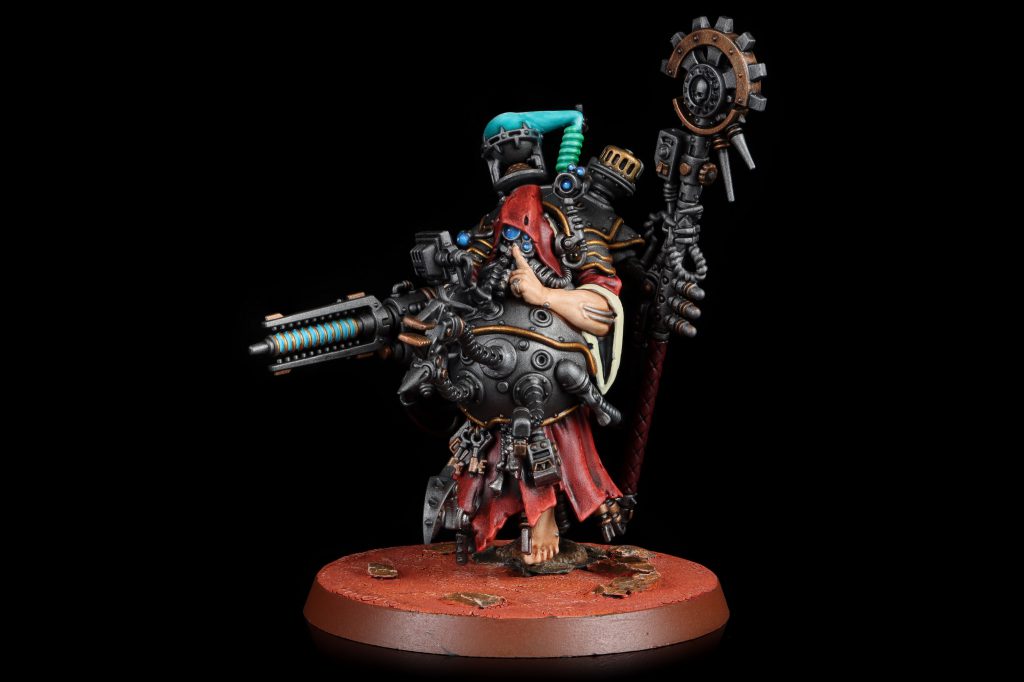
Step 6: Red and Gold Armor Panels
Some Admech models (Kataphrons, Serberys, Dragoons/Ironstriders) have red armor panels traced with a golden accents.
- Base Korne Red. Similar to the cloaks, thin this with a touch of water or flow improver and use a bunch of very, very thin coats.
- Paint the edges with Retributor Armor.
- Wash the Retributor Armor with Nuln Oil. Let the Nuln Oil pool in the place where the red and gold meet, but take care to not let it spread all over the red. Don’t worry about it too much though, as the next step is…
- Clean the Korne Red. Once the wash has dried, simply go back over any areas of Korne Red where the wash spread out too much, and clean it up with a thin layer of Korne Red.
Step 7: Brass Accents
Trace all buttons, Skitarii chest armor ridges, and all those weird little accent pieces covering the model with Brass Scopion. It’s really up to you which elements you want to have the brass highlights, but you can look at the box art for inspiration. Note that the armor panels for Tech-Priests look a bit better (in my opinion) when they are lined with Retributor Armor, whereas the armor panels for Skitarii look better lined with Brass Scorpion. But again, that’s just personal preference.
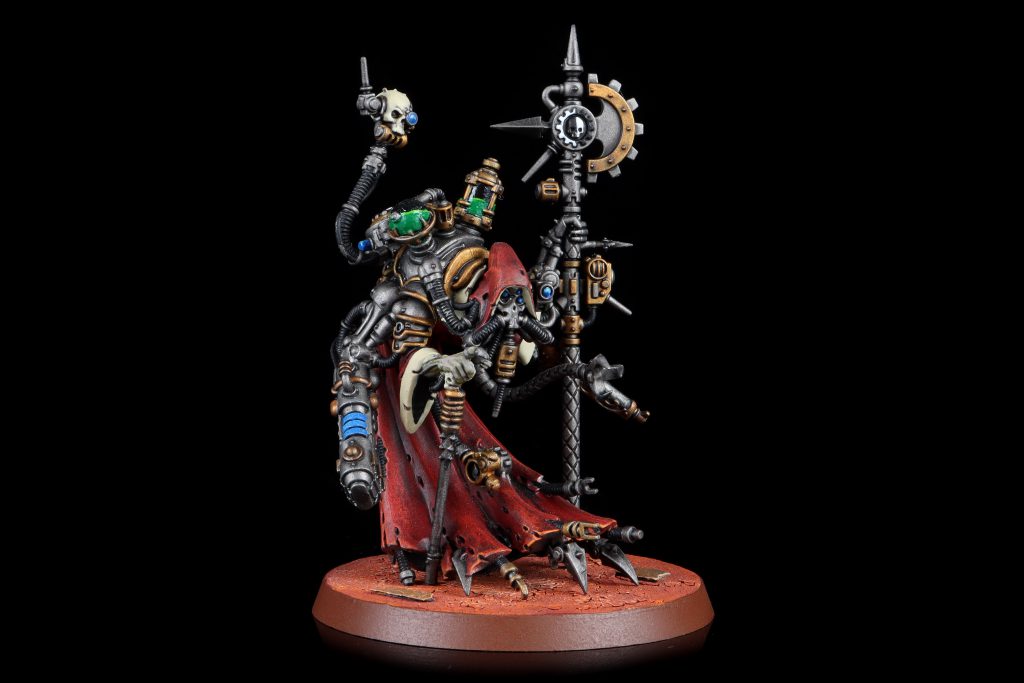
Step 8: Wash, Wash, Wash
Wash all the metalic elements that haven’t previously been washed. I’ve done this in three ways, the first being a light wash with Nuln Oil. The second method I’ve used is a light wash of just Agrax Earthshade. And the last method is a combo of the other two: a very thin wash of Nuln Oil followed by a very thin wash of Agrax Earthshade. Really up to you which method you prefer, though don’t stress about it. They all wind up looking quite similar, and quite awesome.
Step 9: Odds and Ends
The vast majority of your Admech will be painted at this point. But there will probably be some random bits that need some extra TLC. For example, on all my plasma or arc weapons, I paint them with Baharroth Blue, and then trace the raised lines with Retributor Armor.
For the half-white, half-black Admech logo, I’ve painted this more ways than I can count. However, the method I’ve found is the easiest and produces the most consistent result: paint the white parts with Wraithbone and just leave the black parts as silver. If you want to go the extra mile, then paint the black parts with thinned down Abaddon Black, but I tend to skip that as I feel it makes the icon harder to see at arm’s length.
While there are countless additional details you can customize on Admech beyond these steps, these steps should get you pretty close to the box art.
Matthew “Rockfish” Herrington’s Adeptus Mechanicus Scheme
Admech are yet another army I started on a whim while stuck at home with nothing else to do, at this point in lock down that’s like the third time I have done this after I started Necrons and Craftworld Eldar for the sane reason. Yet another common feature with those other armies is that I am continuing to experiment with where I can cheat or otherwise speed up the painting process without losing quality to a degree that would offend me. To that end, this scheme has very few edge highlights and minimum number of different base coats, take a look at this Skorpius for example:

The only edge highlights on this model are in the iconography and the black weapon shrouds, for all everything else I have used a few other ways of getting the different colour shades. The most obvious is the cloaks and cloth which I glazed in the brighter colours in a quick and dirty fashion, where as for the painted armor panels I took a bright initial base coat and used successive washes to selectively darken the ivory.
I do often try to reinvest some of the saved time from the boring bits to getting a bunch of nice little details and lots of glowing lights and weaponry, I find that putting the work in such small things can have a far more compelling final result then going overboard with colours in the core of a scheme.
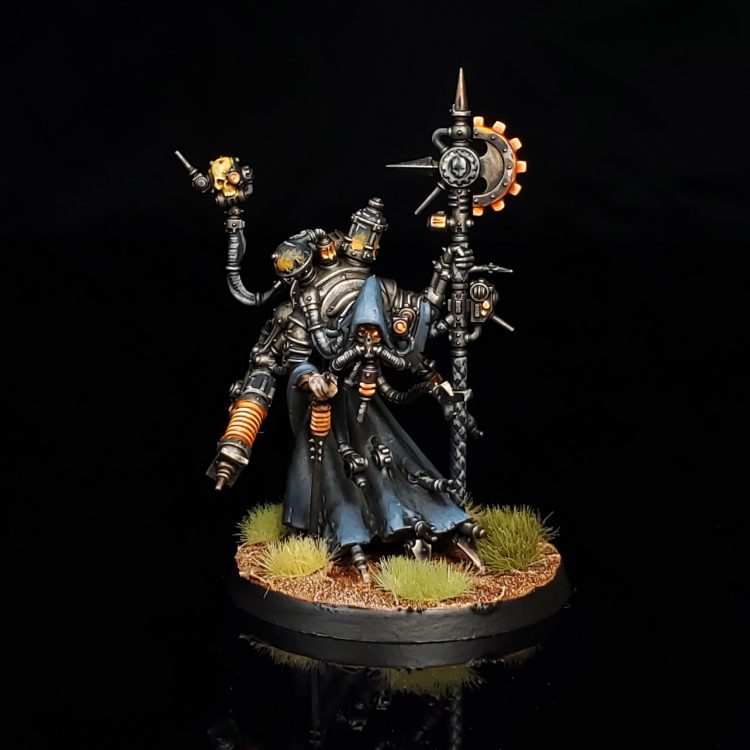
So in this army you can see that I have a couple of main colours in the blue and dirty ivory, but I don’t necessarily have each colour represented evenly across each model. Compare the Skorpius above to the Skitarii Rangers below as examples of polar opposites, there is only a hint of blue from the commander but there are plenty of armor panels in ivory. The Rangers only have the barest hint of ivory on their shoulder lens shroud, instead each has a coat with a hood resulting in a abundance of blue.
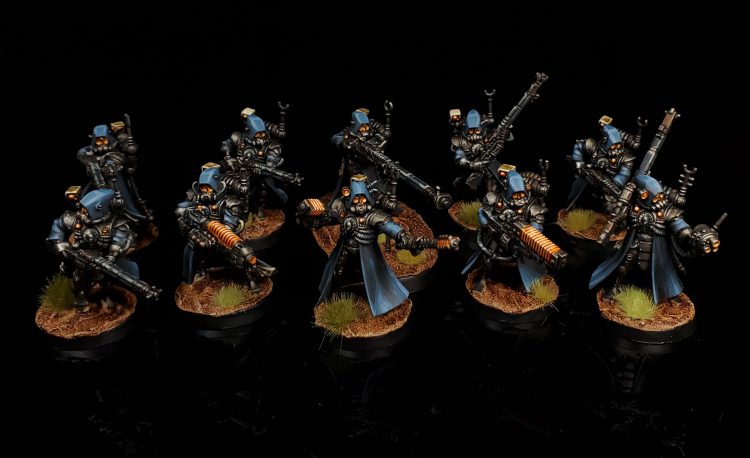
This scheme is one where the army is cohesive as a whole, whenever a colour is missed on one unit it is balanced out in another!
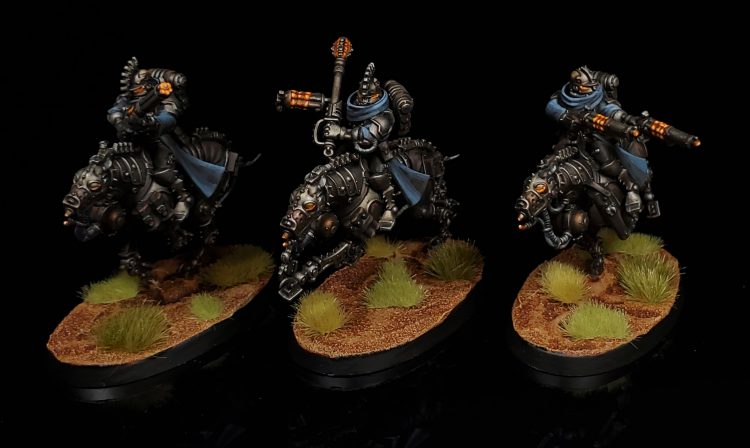
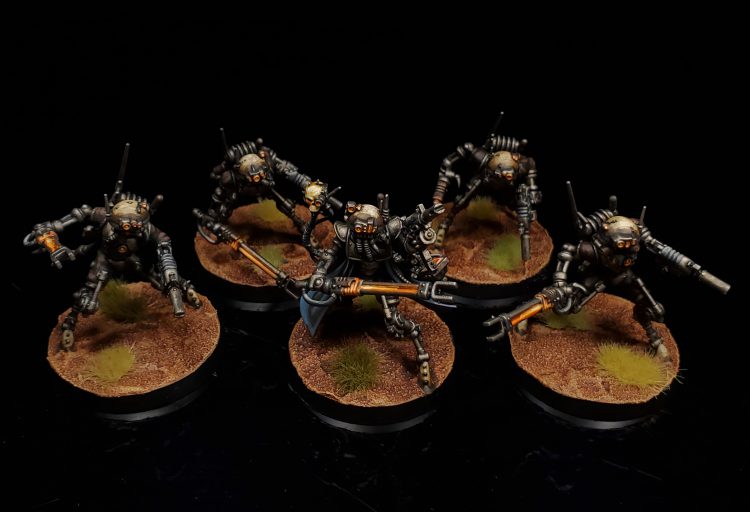
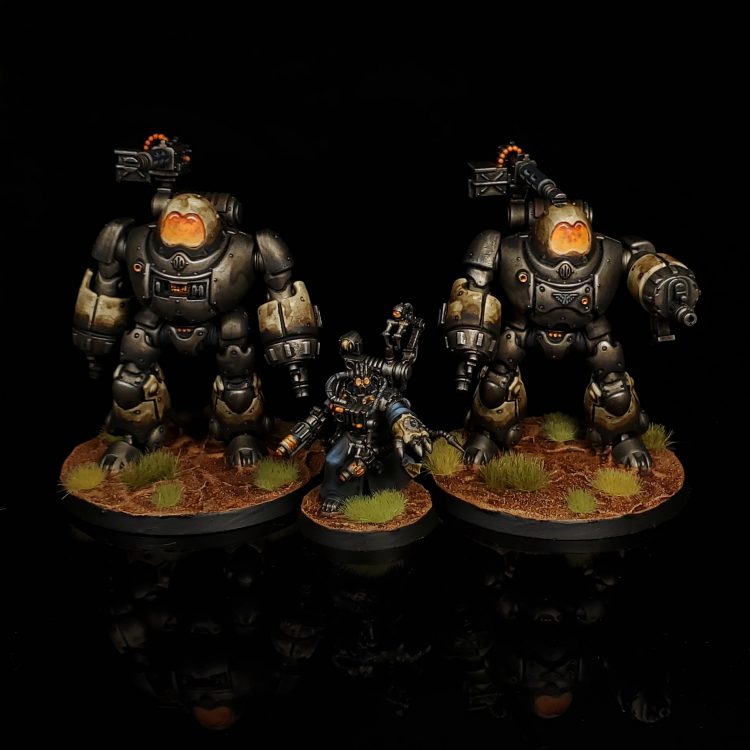
As for the lore of this army that’s my biggest failing with these sorts of things, I have never really been good at either coming up with names or lore for my armies. At some point I will force myself to sit down and come up with something interesting, but in the mean time I might let some sort of narrative form from crusade games or something. As for on the table top, the scheme is not a match for any of the existing forge worlds that I know of, so I can run it as whatever but with the Metalica supplement giving me a option to potentially throw some knights in to get myself a plastic lord of war or three they are pretty tempting possibility!
Clearly I have spent too much time waffling on about the army, so its time to get to the scheme itself!
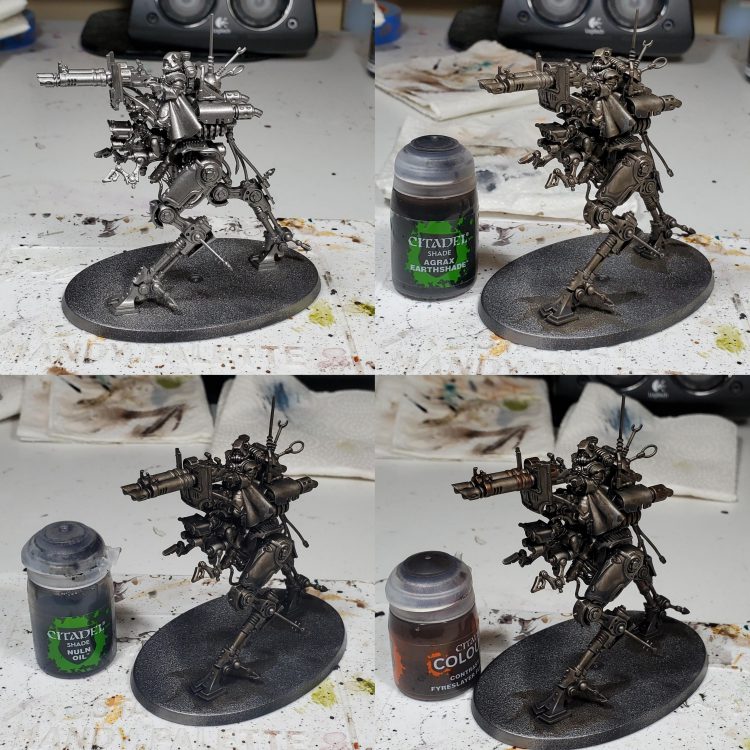
I began by airbrushing Iron Hands Steel over black primer, with Admechs heavy emphasis on mechanical contraptions its far more preferable to me to base coat a minority of the model by hand even if one of the main colours is ivory! After the base coat I threw on a sequence of washes with the intent of making a nice rich steel, while you could skip the Agrax I find that the browns make the metal feel far more real as it has more complexity then just being a flat metallic grey. One of the nice bonuses that starting with a neutral steel is that we can use washes to diversify the types of metal without having to do more base coats, in this case I used Fyreslayer to add some copper/bronze details. If you wanted brass snake bite can look good too!
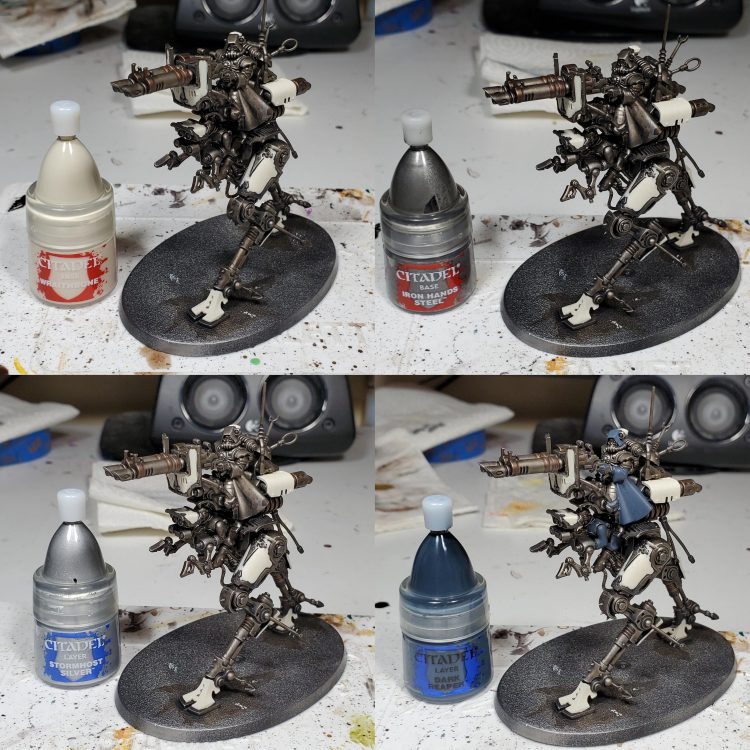
I made a mistake here and started base coating the ivory before doing the metal drybrush, but thankfully the panels are recessed so there was little to no negative consequences. At this point we are actually done the metals, while you could go through and do some edge highlights or fine targeted drybrushing but I am lazy so I will leave that for my marines or necrons.
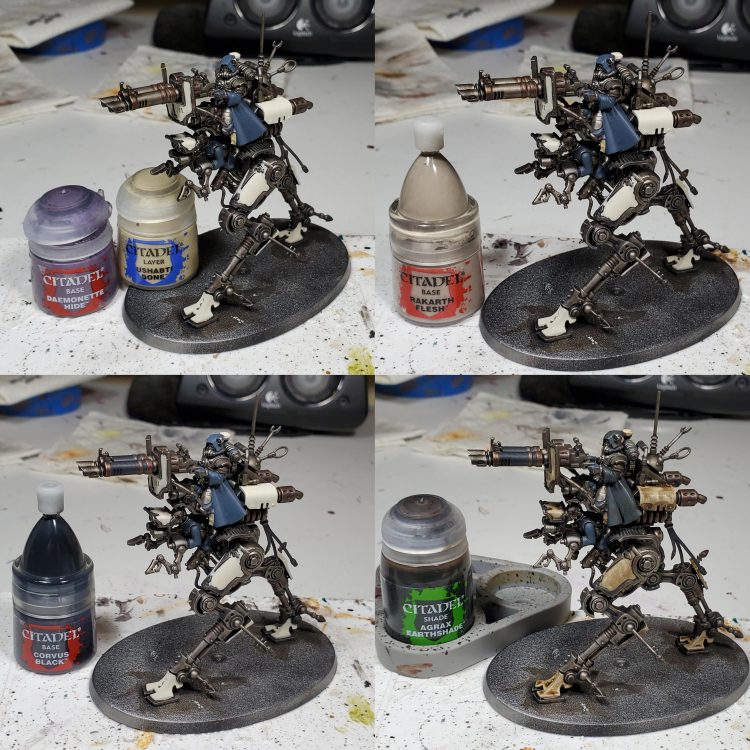
Since its not super obvious the Ushabti and Daemonette are for the seals, while Rakarth is for flesh. I used Corvus to blacken cables and some parts of guns to pick them out, in another area you can cheat I often find on small cables a single coat is sufficient. With that we are done all the non glow base coats and can get to highlights and washes!
I start with drowning the coats and armor panels with agrax, you really don’t need to worry about pooling or getting a little overflow with this as we will either glaze it back up or be pushing it darker anyway so just slap that shit on.
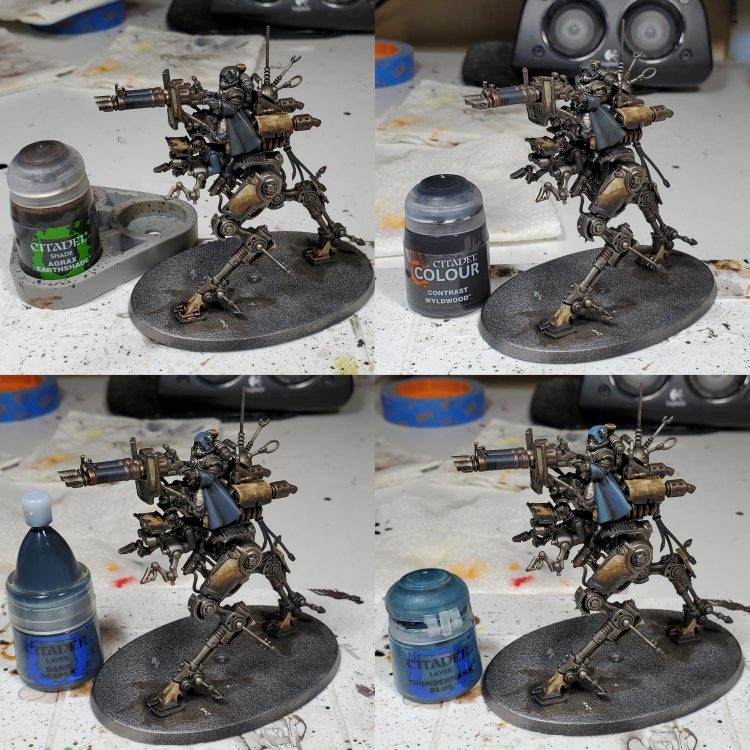
On small things I do maybe one additional coat of Agrax further down the panels, but on something big like this don’t be afraid to do as many as needed to get a semi smooth transition. For the Wyldwood I would suggest doing at least one coat of thinned before going to the straight, I think I did ~3 thinned coats on this model. I also used pure wyld wood to make the leathery underarmor look more appropriate, you probably could use a different undercoat for them but it works out ok over the blue and saves a bunch of time particularly on models with both cloth and leather.
We can also start to glaze the robes, this is still a technique I am working on practicing so don’t mind the imperfections! You can typically get away with not trying to reach the opaque colour that is being glazed on as most of it would get covered by the next colour anyway.
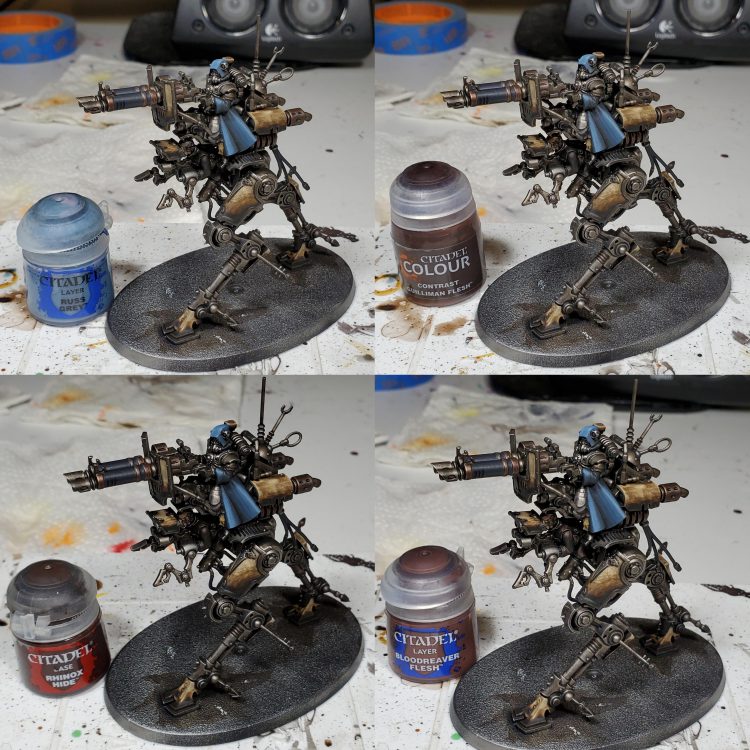
Continuing from the last group of pictures, I finished off the glazing of the coat with Russ be careful that you only go far enough to get a extreme highlight as it is easy to overwhelm the existing blue.
I also realized I had forgotten to wash the skin on servitor, so I did that followed by the simple highlights on the soft underarmor. You could glaze the highlights there too, but I have mostly found it unnecessary as its not really supposed to draw the eye anyway, so some quick and simple strokes on upper surfaces is enough to get the idea across.
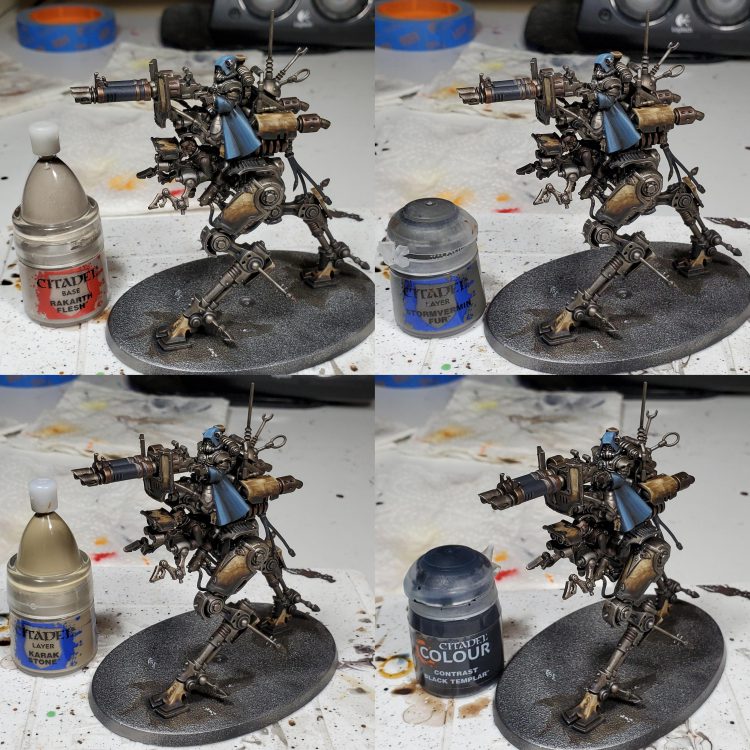
Looks like I missed a picture of the while highlighting the skin here, I did a little bit of flayed one after the Rakarth. Its worth noting that for both I essentially just did a quick glaze, anything more pigment dense can lose the weird dead flesh look we have going on.
Cables and the gun shrouds got highlights of Stormvermin (also used to base coat the iconography!) and Karak, then I used Black Templar to divide the two sides of the iconography.
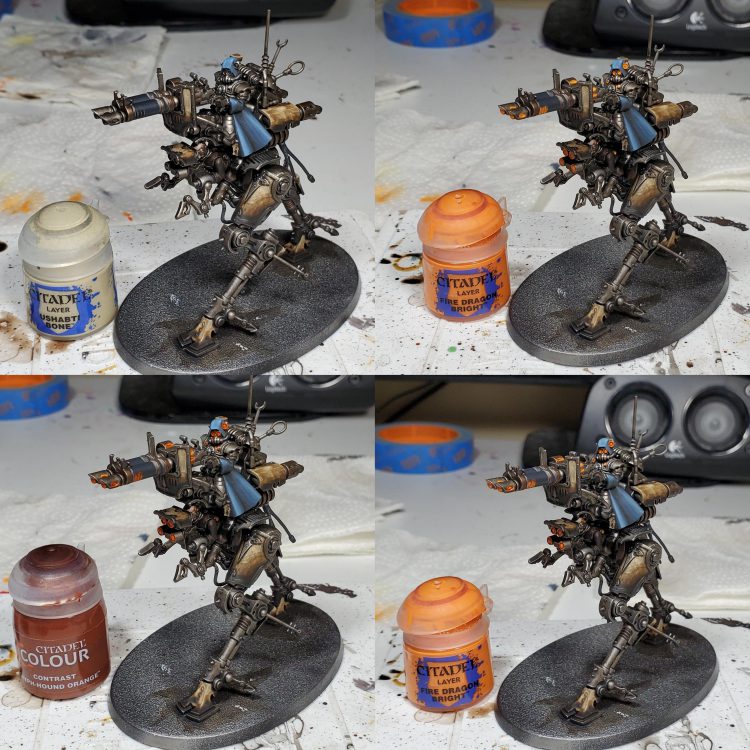
The first highlight of the black part of the iconography is pure Stormvermin, after that I work both sides up by mixing in some Ushabti to each step and only using pure Ushabiti on the ‘white’ parts of the icon. You could glaze this as well, but I am lazy and doing a quick mix on the palette for this kind of thing is fast once both colours are already out.
Now we are onto the last parts of the model itself with the glow/lenses, often on other schemes I try to differentiate those two concepts but I enjoy the cohesive look on admech and it follows the lazy theme I have going on. You can be pretty sloppy with the Fire Dragon base coat, between the wash of contrast and the generally dirty colours of the scheme mistakes can go unnoticed.
Normally for a glow I would not use a wash, but for admech they have a lot of lenses and panels with indentation or other unevenness to the surface, so it helps define those areas as darker and we end up with some good complexity before we even start sketching in the highlights. You can even get a little bit crude OSL by letting the wash overflow a little or placing it where the light would land.
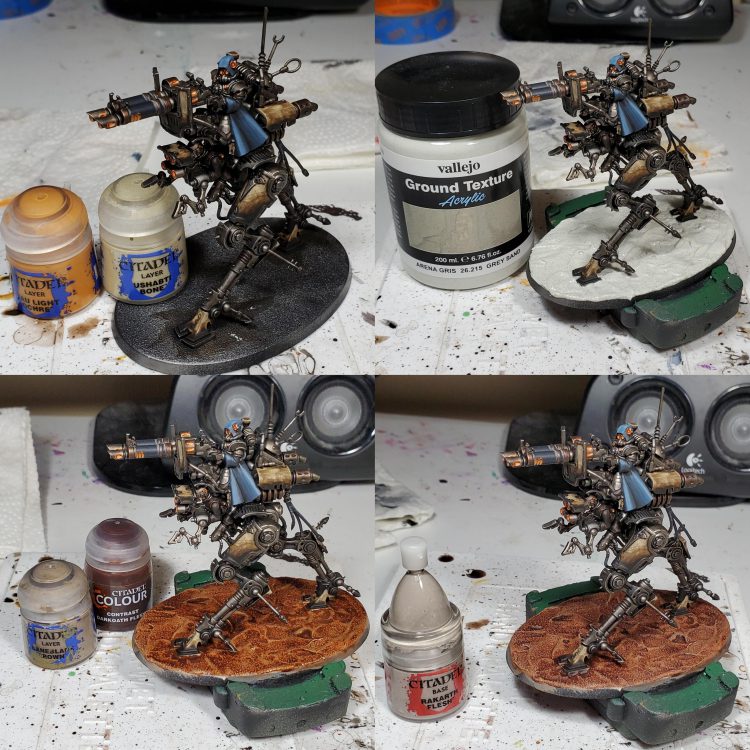
I forgot another intermediate step photo for the lenses, but the idea is mostly clear in that I continued to do finer layers of Tau Light Ochre and Ushabti for the glowing bits. Most of the time just doing a normal opaque highlight/lense effect works just fine, but if you look at the Kastelan Robots up at the top, you might notice that I glazed in the colours on the face plates so it would not be too stark.
On the bases after waiting for the paste to dry, I painted the whole thing with Baneblade Brown before slopping on Darkoath Flesh followed by a quick drybrush of Rakarth. After that I varnished the model with Vallejo Mecha Matte, then cleaned up the rims with Abaddon Black and finished off the model by sticking some tufts from Gamers Grass on. I prefer the following but feel free to deviate:
- 6mm Dry Green
- 4mm Beige
- 4mm Light Green
With that you are done!
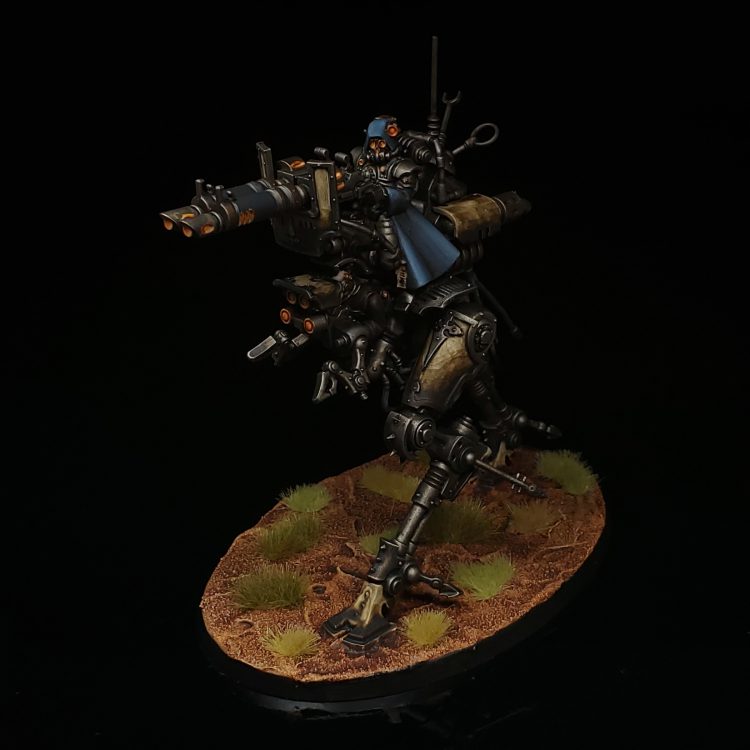

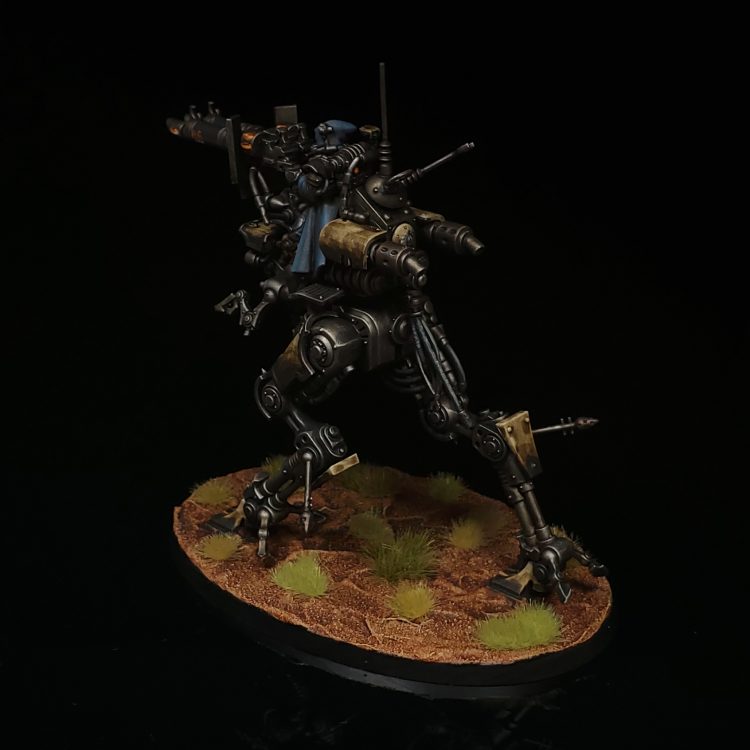
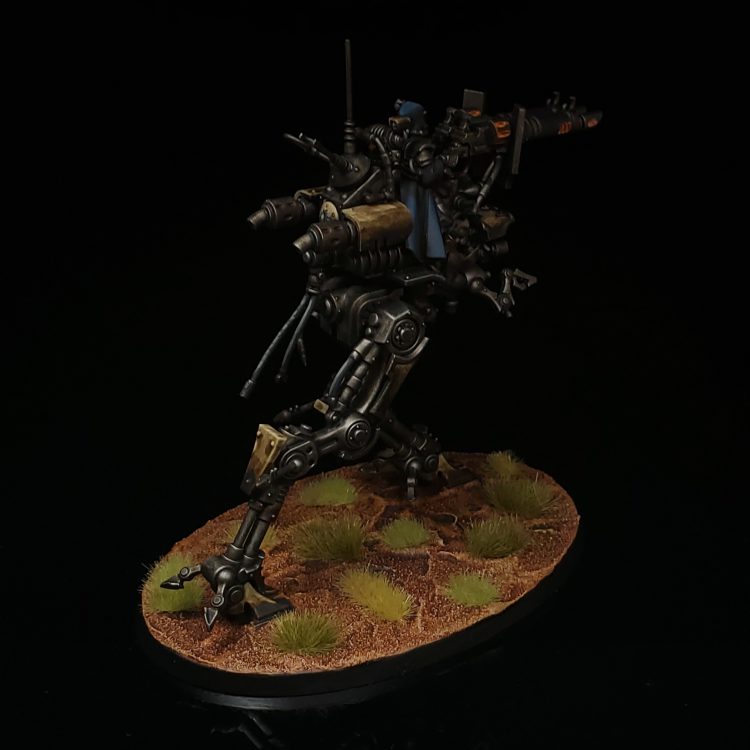
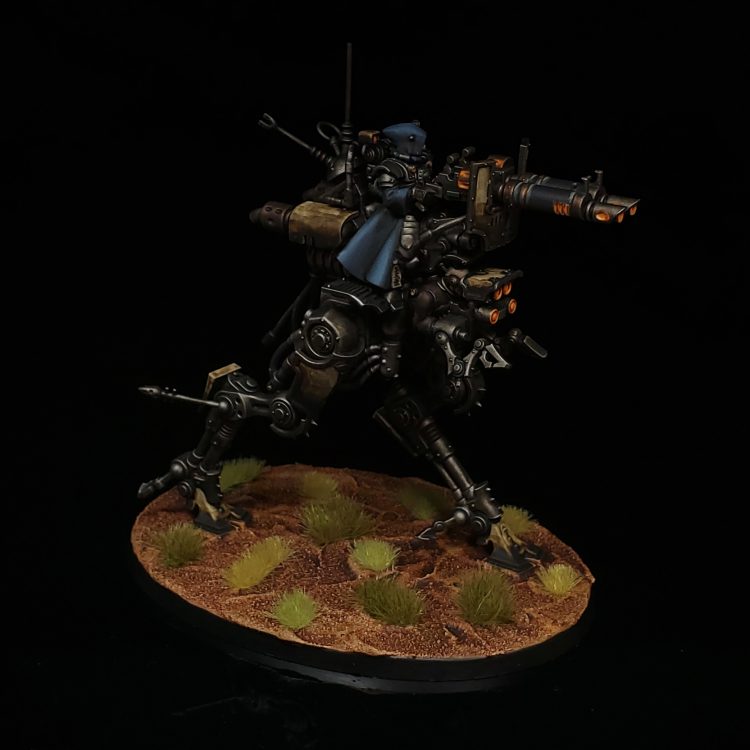
Daniel “Zuul the Cat” Rucker’s Method
My Adeptus Mechanicus army was the first I painted after taking a long hiatus from both wargaming & painting. They’re amazing models with tons of details that look fantastic on the table top. The background information in the Adeptus Mechanicus codex really serves as inspiration for just how to paint your army. All the paints I used on these models were Citadel paints & for units like Skitarri they really benefit from a sub assembly – simply don’t glue the legs to the torso until after you paint them. Here’s how I painted my Forgeworld Mars scheme.
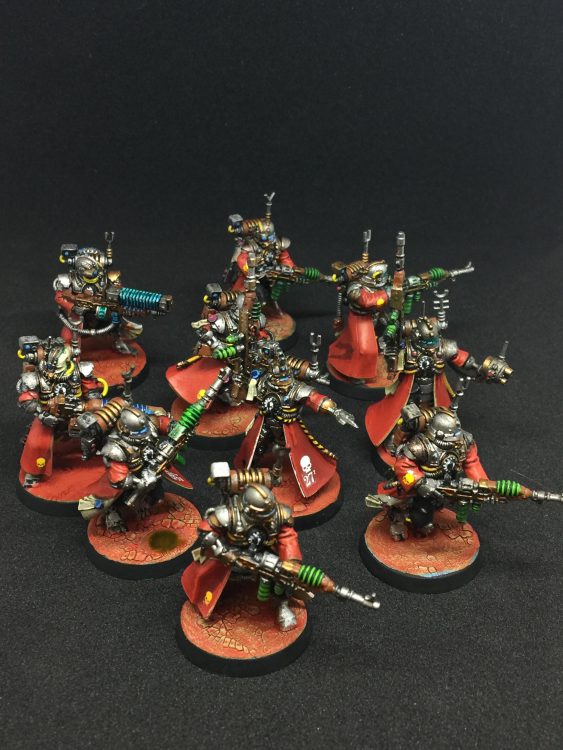
Start by priming the entire model black – once this is done you’ll paint the entire model with base coats then give the entire thing the same wash. Pick out the metal parts of the models (there’s a lot on AdMech!) with Leadbelcher. For all the ornamental parts of the model (like the raised ridges on the helmets, the lining of the shoulder pads & chest pieces, the casing of the Radium Carbines) use Brass Scorpion. The codex describes the weaponry of the Skitarii as ancient weapons mixed of wood and metal. Because of this I picked all the bodies of the rifles out with Dryad Bark. For whatever reason I associate electricity with the color blue and radiation with the color green. Since Radium Carbines are radiation guns, paint all the coils on the top and the power cell on the bottom with Caliban Green. Any electricity based weaponry, like Arc Rifles, as well as the eyes of Rangers/Vanguards get a base coat of Macragge Blue. Lastly, for the overcoats, paint them all with Mephiston Red on the outside and Celestra Grey on the inside. Once you’re done with the base coat, shade the entire model with Agrax Earthsade. While it’s still wet, do another coat of Nuln Oil on the metal bits directly over the Agrax Earthshade.
Because AdMech armor is so ancient, I don’t really like highlighting them up to a very bright level. Simply go back over all of the base colors again but leave some shade near edges/recesses. For the Radium Carbines, pick out all the raised sections with Moot Green. For the eyes & electric weapons, you’ll want to pick them out with Temple Guard Blue. Redo a basecoat of Celestra Grey on the inside of the coat, followed with a layer of Ulthuan Grey, finishing off with a edge highlight of White Scar. For the outside of the coat, layer back up with Mephiston Red and Evil Sunz Scarlet on the most raised areas. All the cables are painted with a hazard stripe style. To achieve this, start a base coat of Averland Sunset followed with Yriel Yellow. Once that’s try, use Abaddon Black to paint vertical stripes – each one should be the width of the small brush you’re using with no pressure applied. To make it look like a cable I give them a coat of Gloss Varnish (Vallejo). The last step I like to do on all Adeptus Mechanicus models is to paint the Cog. Start by painting the entire thing Celestra Grey. Then, paint the right half of the cog and the left half of the skull with Abaddon Black. Wash the entire thing with agrax earthshade, then just pick out the white the same way the coats are done – Ulthuan Grey followed by White Scar.
With that done, your Adeptus Mechanicus Skitarii are done! This paint scheme can be repeated throughout the range. Techpriests also look great painted in this same scheme!
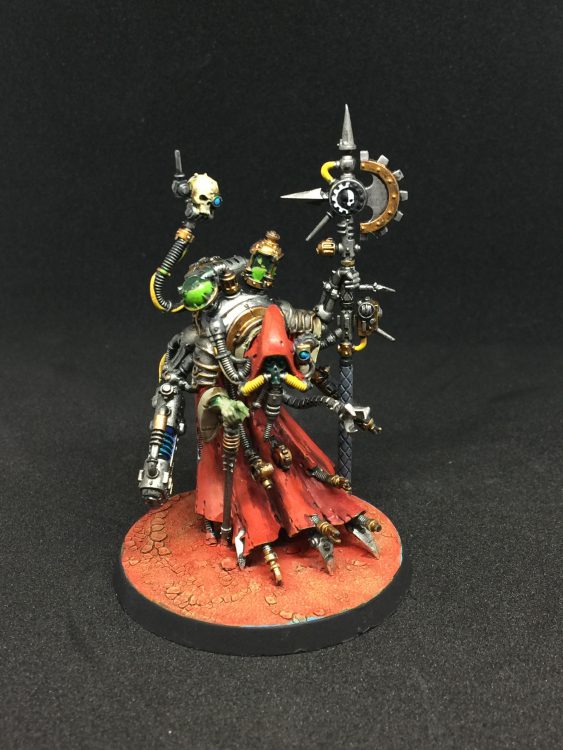
Liam “Corrode” Royle’s Method
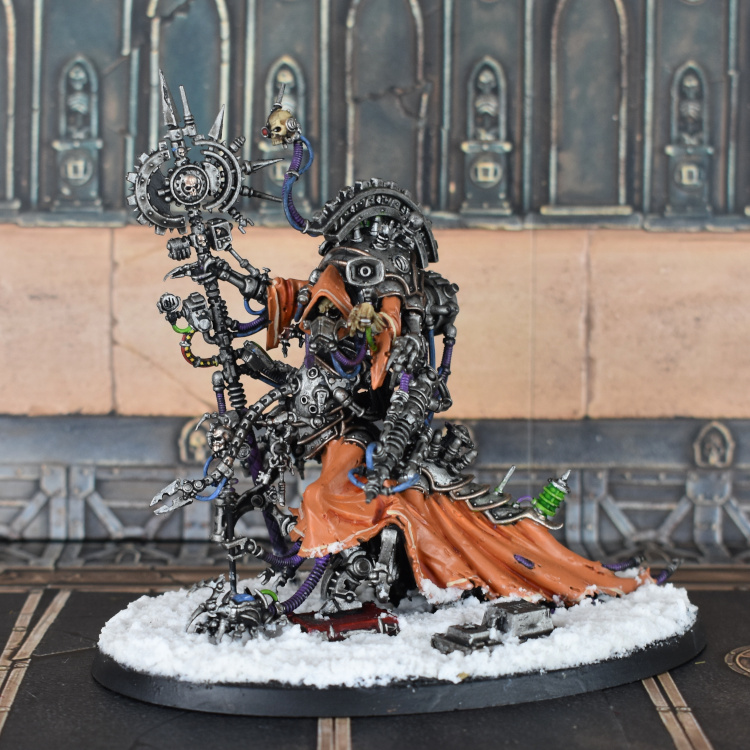
My take on the Adeptus Mechanicus was a little less traditional than some others. I decided the main robe colour should be orange rather than red, partly to be a little different and partly inspired by Buddhist monks. I expected this to be a bit of a bear, but it honestly turned out to be very simple – Jokaero Orange covers nicely and is the exact colour I want, so I just layer that, wash with thinned down Feugan Orange, re-layer Jokaero, and hit high points on the robes with Fire Dragon Bright. The Tech-priest Enginseer below was painted a little later than Cawl, and so he got a small amount of yellow as well right on the edges.

The metals are just Leadbelcher washed Nuln Oil and then highlighted with some Ironbreaker. The edges of Cawl’s armour and the brassy areas on the Enginseer are done with Runelord Brass – mixing up the metal tones on Ad Mech is helpful for keeping them visually fresh, especially with single-colour robes. Similar applies to the cables – Cawl has a lot of blue and purple, which contrast nicely with the orange robes, and the Enginseer has even more of a mix with green and yellow in there as well.
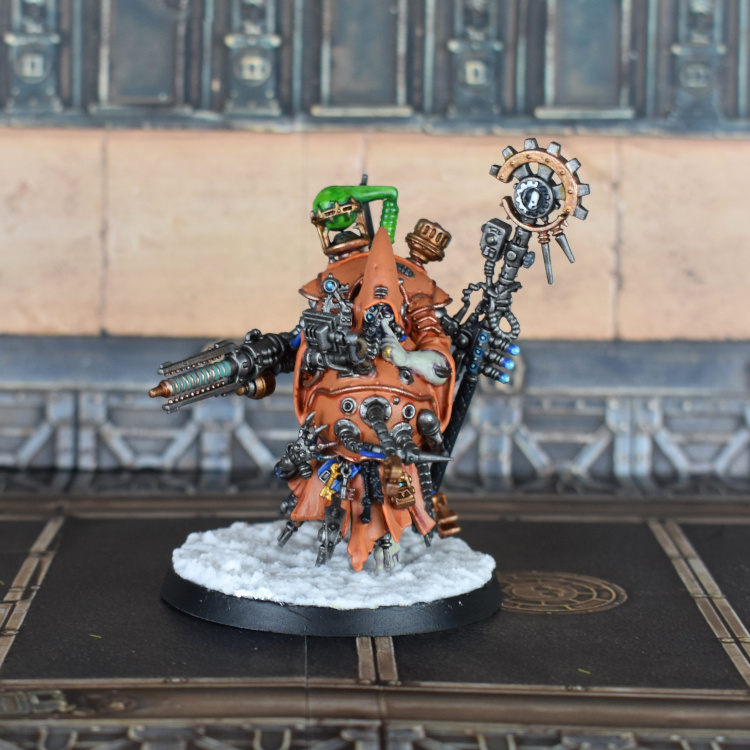
The Manipulus has some similar elements but was painted a lot later – you can tell because I actually bothered painting the Mechanicus symbol in black and white! His skin is how I would normally paint the kind of sickly skin of a Tech-priest now – Ionrach Skin washed with Druchii Violet and then re-layered with Ionrach and then Pallid Wych Flesh. From memory, Cawl’s skin was Ushabti Bone or possibly Flayed One Flesh washed Seraphim Sepia. The important thing is that they felt appropriately sickly. The Manipulus also has a slightly different take on the non-silver bits, with my new favourite combination of Brass Scorpion and Sycorax Bronze; his magna-rail lance has a similar effect, but then with Nihilakh Oxide washed into the recesses, which works for either copper oxidation or, in this case, a more restrained glow. As ever, the blues here have my new favourite Baharroth Blue to really make them nice and bright.
Speaking of breaking up colours, green makes an excellent contrasting colour with this scheme. The Manipulus has his green retort full of mysterious liquid, and on Cawl I attempted some OSL which isn’t normally in my wheelhouse – the important thing here was to make sure the central light source was bright enough that it actually looks like it’s glowing. I touched this up recently by adding more yellow into it, and I think that really helps give it a sickly green glow – perfect for the “weird science” feel of the Ad Mech.
PierreTheMime
I’ve had a couple Start Collecting Skitarii boxes sitting on my shelf for years, always taking a back seat to other projects. The reason was primarily that I’d tried a few schemes in the past but never really hit on anything I was happy with until I bit the bullet and went with a standard scheme. Stygies VIII not only has some pretty great rules, but uses some black to offset all the red which I like.
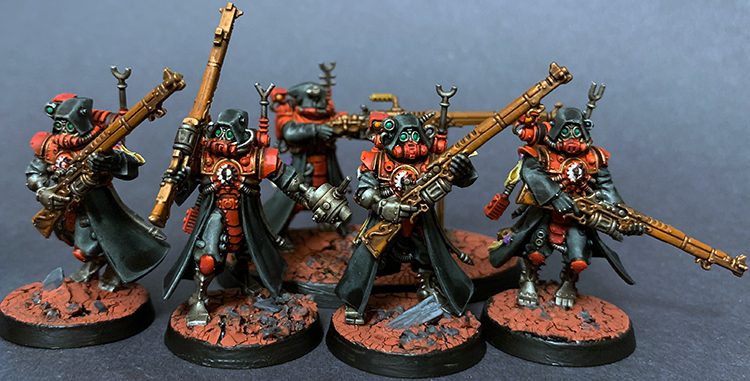
Having dealt with numerous horde armies, I was really looking forward to trying out contrast paints as a “cheat” to complete large numbers of infantry quickly. Did it work? Yes*. It was much faster than my normal painting process and the detailing with contrast is very satisfying, but has a lengthy drying period and does not work well on flat surfaces.
The end result on this process is a pretty decent tabletop standard, which for me is “good enough” as I just want to see these robo-dudes finally hit the table painted. If you’re interested in the same hopefully you’ll find this useful.
Assembly: I fully assembled every model and lightly glued it to their base, emphasis on light.
Priming: Since I’m using Contrast paints on 75% of these models, I used Wraithbone spray for my primer. It gives all the colors a nice bright pop.
Step 1: I went for getting all the non-armor metallics coated first, using Leadbelcher base. If I made any errors and went onto any of the armor/cloth, I touched it back up with Wraithbone base so it didn’t show in the next step.
Step 2: Next up is cloth, which I’ve done using Black Templar constrast. As contrast pools easily, so I had to be careful to catch and pull off any excess as I went. Another interesting trait of contrast is that you can pretty easily miss little spots and it shows, so after I think I’ve done a full coat I turn the model over a few times at different angles to make sure I don’t need to do any touchups. As with Step 1, if I accidentally hit the armor with black I wait for it to dry and then fix it with Wraithbone.
Step 3: Armor time! I coated all armor bits in Blood Angels Red and let it dry. As this is the final “big” contrast step it’s important to be careful you don’t overdo it and go into other areas.
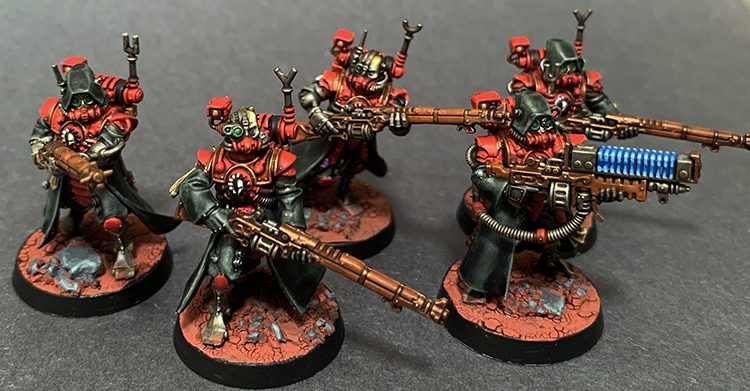
Step 4: “Small” contrasts. I wanted these to have an unhealthy tone for their skin as I assumed their meat-bodies were not quite happy being cut away/jammed with wires, so I’ve used Plaguebearer Flesh. For skulls (where applicable) I used Skeleton Horde (surprise).
Step 5: Now onto my favorite step, detailing. I used Balthasar Gold as an armor border and equipment highlights. Pouches and straps are done with Balor Brown. Primary lenses are done using Warpstone Glow and I’ve used Fire Dragon Bright for secondary lenses and lightbulbs. Skulls I added a secondary layer of 50/50 Ushabti Bone and Wraithbone on raised surfaces.
Step 6: Hit the entire model with a liberal application of Agrax Earthshade, my one and only shade. It gives everything a dirty, dark, and natural feel which I love. As with constrasts I have to watch out for pooling.

Step 7: Reapplying basing and highlights. I touched up areas I feel were made too dark by the shade, using either the base colors (if non-contrast) or smooth constrast areas out with colors I felt matched well enough. For Blood Angels Red over Wraithbone, I found that a 60/40 mix of Mephiston Red and Fire Dragon Bright worked well to match. To do edge highlighting I just upped the FDB until I felt it stood out well enough. Bone I touched up with a slightly watered down Wraithbone and then highlighted with a 50/50 Wraithbone/White Scar mix.
Step 8: Final touchups and basing. I gave each model a once-over to catch any areas I may have missed and needed to attend to. Once one, I popped each model off their base and set them aside. I did a pretty standard base scheme, gluing down some medium-size grit and some slate chips and then priming the whole thing in Abaddon Black after they’ve dried. Next I hit the flat base area with a thick layer of Martian Ironearth and the rocky area with a 50/50 mix of Ironearth and water, which allows it to give the rocks the color without forming the cracks of flat surfaces. Finally I hit the tops of the exposed rocks with a 75/25 mix of Abaddon Black and White Scar and then a 50/50 mix for a final highlight.
Step 9: Finally I glued the models back in place with tacky glue (the flexibility of the glue allows the models to stick but still have some give if they fall or get struck with something). Once they’ve dried in place I touchup the points where they attached with Martian Ironearth to cover any glue marks and coat their feet/robes with a thin watered down layer to create a simple dust effect.
Step 10: Destroy enemies of the Omnissiah.
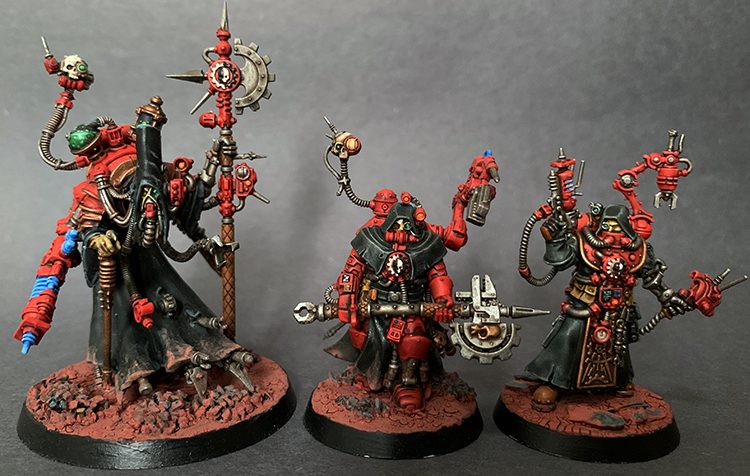
elye
For my approach to Ad Mech, as a fairly recent returnee for the start of 8th edition and never the best painter when I was a kid, I made the uninformed move of aiming for a white paint scheme for my first army. Little did I know, that this is starting on hard mode. Initially I followed the “Citadel/ GW Metalica scheme” (Rakarth flesh layered with many coats of Pallid Wych Flesh). This is hard to shade and pretty time consuming to do, plus it often comes up looking pretty flat on larger models. I started experimenting using gloss varnishes to give fake highlights of shine, but have now settled on the method below for larger models.
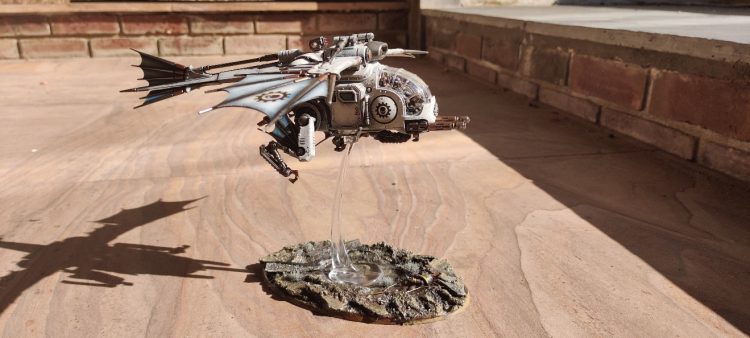
This method feels all sorts of wrong as you go about it, but has an undeniable effect and the model look great when you are done. The secondary colour for my army is blue with copper accents. This Stratoraptor has gone from start to finish in under 24 hours ( this model is fragile and going to break, I have already lost spline from the leg fins …..)
This was assembled in sub-assemblies with the two halves of the body worked on separately, as many large parts as you can manage and most of the guns, legs, etc., can be worked on individually.
Prime all the body panels / hull along with the wings, with Wraithbone spray, you could use any cream or white primer through an airbrush. Base coat the fabric on the wings with Thousand sons blue. I used an airbrush for this until I broke my needle tip, doing this by hand with a larger brush is fine as you won’t see the brush lines after the later stages.
Smother everything that’s white with heavy coat of Basilicanum Grey Contrast, get it into all the recess. I let this this dry overnight, but you could also use this time to take out shades for the wing canvas recesses. Here a combination of Druchii Violet and Drakenhoff Night Shade is streaked all over along with some black into the deepest corners.
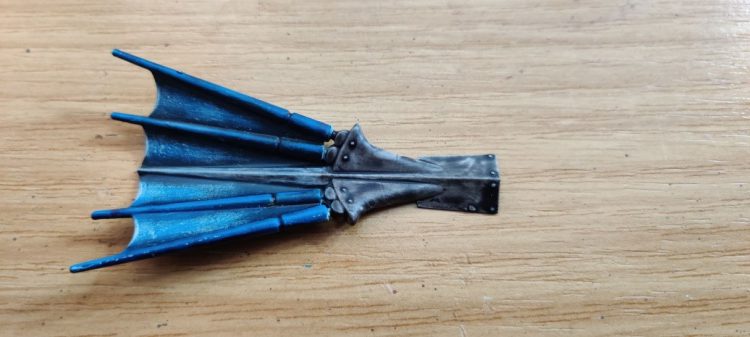
Drybrushing time: using a circular motion effect and a larger drybrush take Wrack White and work up to Praxeti White and slowly build up over the area’s you want to leave white. If you take this too far you can wash it over with Dark contrast and go at it again, just try to leave the areas that would be naturally dark darker, such as the bottoms where the shadows would fall.
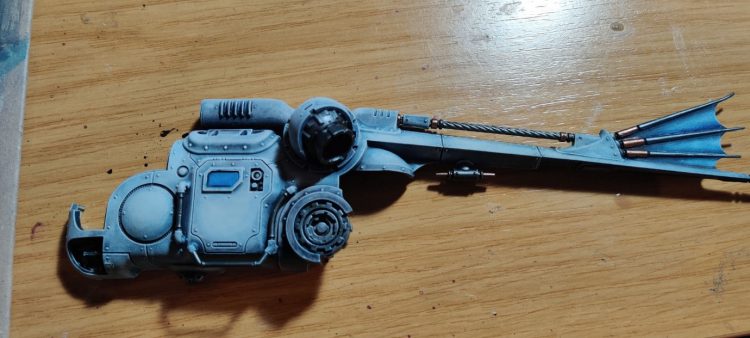
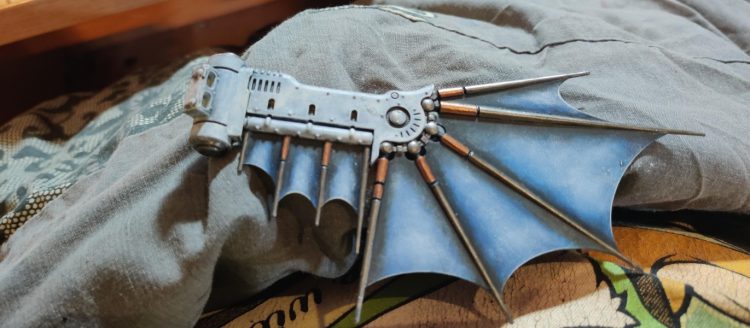
Using the same technique, whiten over the dark blue on the wing’s focusing on the area’s you want to seem more transparent these photos’ were taking after some base coating over some of the metal details had started …
All that’s left at this point was to go over details, picking some complementary colours such as a blues and coppers, with the occasional splash of red for things like missile. I love Metal Colour Shining Silver and Exhaust Manifold along with Hashut Copper for copper accents .
Basing wise, I used Polyfilla and broken cork to make up a crater. I then sealed it with watered down PVA glue and some bits from my bits box. It was then primed and dry-brushed up from brown to tan then a grey for the final topcoat. The dead Red Scorpions marine is a nod to a pal who has been moaning about the lucky Ad Mech players with new fancy toys …you know who you are.
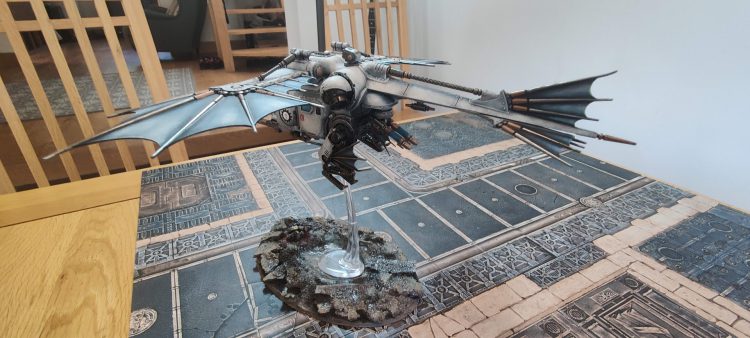
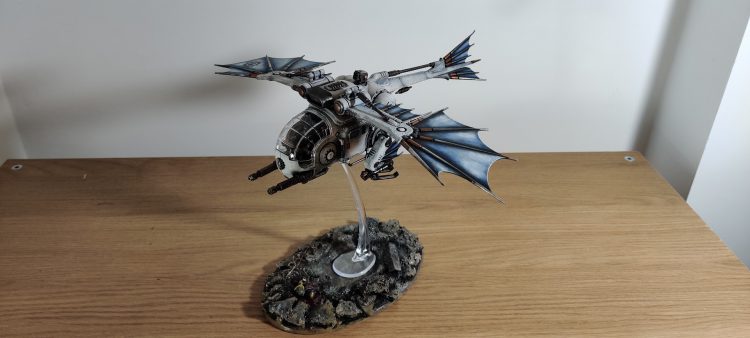
Beanith’s Smooshing with Contrast
Angry screeching in binary
01001001 00100000 01110111 01101111 01101110 01100100 01100101 01110010 00100000 01101001 01100110 00100000 01100001 01101110 01111001 01101111 01101110 01100101 00100000 01110111 01101001 01101100 01101100 00100000 01100010 01101111 01110100 01101000 01100101 01110010 00100000 01110100 01110010 01100001 01101110 01110011 01101100 01100001 01110100 01101001 01101110 01100111 00100000 01110100 01101000 01101001 01110011 00111111
<Editor – Damn it Beanith, we’ve talked about this, you’re too big for the R2D2 costume. Stop messing around and get on with the HTPE Admech>
Sad Binary tooting
<Editor – Stop that and get back to your “burbling”>
Killjoys. Fine, one quick and dirty guide for painting the seven main Forgeworlds… which turns out is pretty much the same five colours (red, white, grey, black, brown) in different patterns. Oh and those orange Ryza nerds as well that I totally didn’t forget about.
As always, my guide is showing you the beginner’s way of smashing through the little guys so you can focus more on all the lovely tanks, robots and the knock-off squat Gyrocopter Archaeopter.
I primed everything with the Vallejo Hobby Paint Spray – Gunmetal to an effort to save some time on all the metal bits and then found myself subsequently pissing away all that “saved time” on multiple thin coats of Greyseer/Wraithbone on the cloaks because I are genius. So maybe not do that? And then Aethermatic Blue on the visors, lenses, capacitors and weapons. Wyldwood also worked a treat for a nice bronze/copper colour over the Gunmetal too.
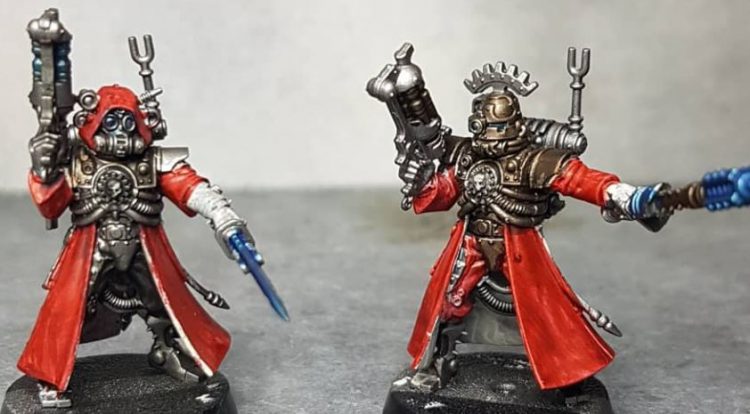
Mars – We can sing two songs!
Cloak – Blood Angels Red on the outside, Wraithbone on the inside.
Pants – Greyseer
Armor – A touch of Wyldwood
Graia – Falling back is for losers anyway.
Cloak – Blood Angels Red on the outside, Wraithbone on the inside.
Pants – Blood Angels Red
Armor – Wyldwood
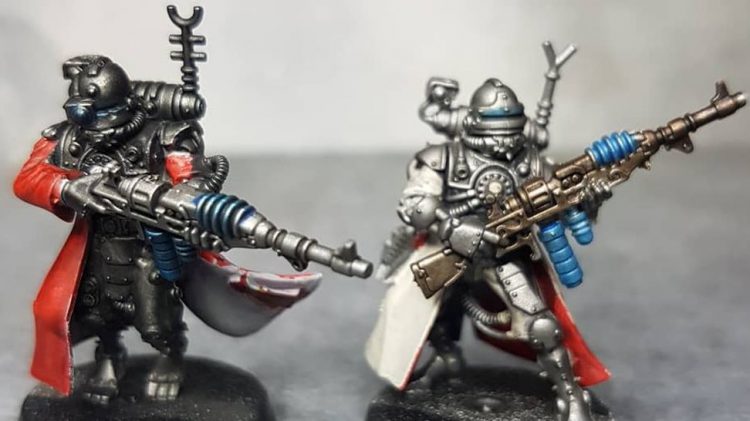
Lucius – Has fabulous hair and a bitchin Cane/Wand. Oh wait, that’s the other one.
Cloak – Blood Angels Red on the outside, Greyseer on the inside.
Pants – Wraithbone
Armor – Black Templar
Metalica – Hates Napster and can run and gun.
Cloak – Wraithbone on the outside, Blood Angels Red on the inside.
Pants – Wraithbone
Armor – Untouched.
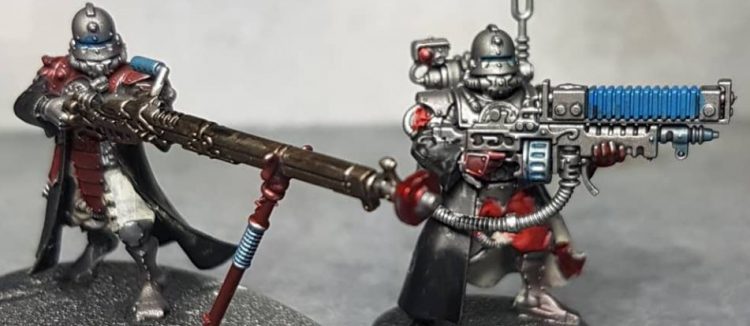
Stygies VIII – Nerfed hard to hit.
Cloak – Black Templar on the outside, Black Templar on the inside.
Pants – Wraithbone
Armor – Blood Angels Red.
Agripinaa – Gesundheit, overwatch on a 5+
Cloak – Black Templar on the outside, Wraithbone on the inside.
Pants – Blood Angels Red.
Armor – Untouched
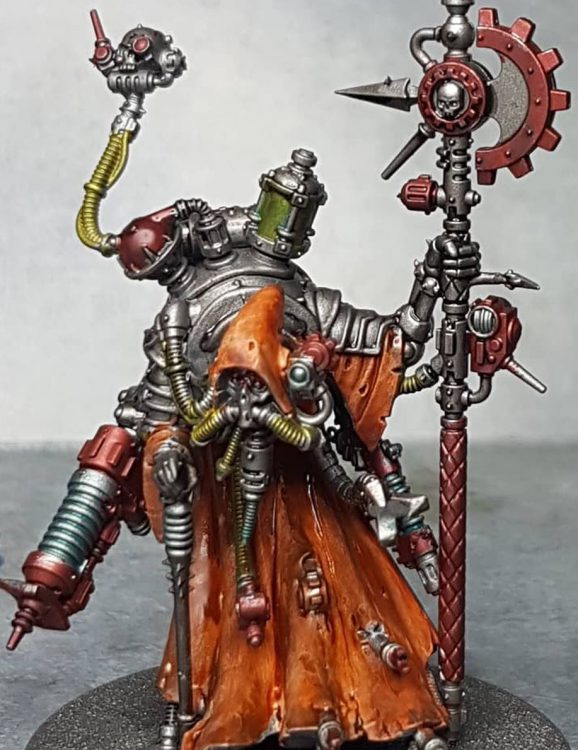
Ryza – Rerolls in the fight phase for an army that’s heavily biased towards shooting? Yes please.
Mostly just Gryph-Hound Orange and then lots of spot colours using Blood Angels Red and Iyanden Yellow because I was hungry and wanted McDonalds?
Bosh, now slap on some Nuln Oil and call them done son. Not the prettiest of models I’ll agree and I was pretty intimidated by all the details but with some gentle encouragement/prodding I managed to finish these guys to a standard that I’m happy with for an army that mostly lives unassembled in my pile of shame.
And as always,
01010011 01110111 01101111 01110010 01100100 01110011 00100000 01100001 01110010 01100101 00100000 01100010 01101111 01110010 01101001 01101110 01100111 00100000 01100001 01101110 01100100 00100000 01100001 01110010 01100101 00100000 01101000 01100101 01101100 01101100 01100001 00100000 01101100 01100001 01101101 01100101 00101110 00100000 01000001 00100000 01110000 01110010 01101111 01110000 01100101 01110010 00100000 01110111 01100101 01100001 01110000 01101111 01101110 00100000 01101001 01110011 00100000 01110100 01101000 01100101 00100000 01100001 01111000 01100101 00101110
<Editors – Damn it Beanith!>
Runs off Warbling
Wrap-up
There’s a bunch of different ways to paint Adeptus Mechanics and we can only look at a few of them here, but hopefully you’re inspired to crack on and paint your own army of robot people (no, not Necrons, the good robot people). Ad Mech are an interesting range with a lot of disparate elements, so you can have some real fun trying out different things with them and then trying to tie all that back together into a cohesive scheme. As always, if you have any questions, feedback, or models of your own to share, feel free to drop a note in the comments below or email us at contact@goonhammer.com.


